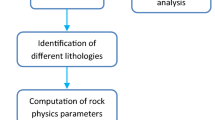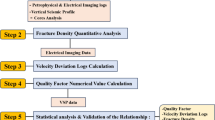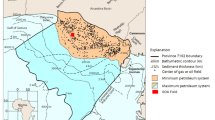Abstract
Geomechanics is a science that studies rock behavior under stress conditions. The major purpose of this study is to use seismic geophysics (Elastic wave) to examine the geomechanical properties of the Fahliyan reservoir zone in one of Iran's oilfields. The amount of compression and shear wave velocity were determined by processing vertical seismic profile (VSP) data to obtain geomechanical parameters from the P-wave and S-wave velocities. First of all, elastic moduli have been calculated. These factors were then empirically translated from dynamic into static modules. The K-Mean clustering approach was employed in this research to cluster geomechanical characteristics and determine geomechanical units. The key criteria for investigating wellbore stability and predicting the safe mud weight window are pore pressure, minimum horizontal stress, maximum horizontal stress, and induced stress from drilling operations. The quantity of uniaxial resistance is another critical parameter calculated by the porosity of the petrophysical logs and empirical equations comparing elasticity modulus and uniaxial stress resistance classification with bit size and caliper log. The drilling safe mud window was defined by applying a minimum and maximum pore pressure. Extensive fractures may occur if drilling fluid pressure predominates over the maximum horizontal stress. The amounts of induced tensions and shear fractures, as well as their locations, were used to identify suitable sections for hydraulic fracturing along the Fahliyan reservoir zone. This method can determine the possible zones for hydraulic fracture with analysis and comparison of VDL and UCS. The current research will benefit the petroleum industry by minimizing the problem of drilling.
Article highlights
-
Geomechanical parameters were obtained from P-wave and S-wave velocities.
-
The K-Mean clustering approach was employed in this research to cluster geomechanical characteristics and determine geomechanical units.
-
Possible zones for hydraulic fracture were determined with analysis and comparison of VDL and UCS.

















Similar content being viewed by others
Abbreviations
- VSP:
-
Vertical seismic profile
- UCS:
-
Uniaxial compressive strength
- VDL:
-
Velocity deviation log
- E:
-
Young's modulus
- σ:
-
Stress
- K:
-
Bulk modulus
- β:
-
Materials compressibility coefficient
- Vs :
-
Shear wave velocity (m/s)
- Vp :
-
Compressional Wave Velocity (m/s)
- ρ:
-
Density (g/cm3)
- G:
-
Shear modulus (GPA)
- ν:
-
Poison's ratio
- Ed:
-
Dynamic Young modulus
- νd :
-
Dynamic Poison’s ratio
- νs :
-
Static Poison’s ratio
- ρb :
-
Bulk density
- ρf:
-
Formation fluids density
- Φ:
-
Porosity
- εx :
-
Linear integers on the X
- εy :
-
Linear Integers on the Y
- α:
-
Biot constant
- δHmin(Shmin):
-
Minimum horizontal stress
- δHmax(SHmax):
-
Maximium horizontal stress
- δv(Sv):
-
Overburden Stress
- \(\delta \) zz :
-
Tangential induction stress
- \(\delta \) rr :
-
Axial induction stress
- \({\delta }_{\theta \theta }\) :
-
Tangential induction stress
- ΔP:
-
Difference pressure
- DITF:
-
Drilling induced tensional failures
- Δx:
-
Distance between two geophones
- ΔT:
-
First-time arrivals difference
- V:
-
Average interval velocity
References
Abdideh M, Moghimzadeh MA (2019) Geomechanical study of gas reservoir rock using vertical seismic profile and petrophysical data (continental shelf in southern Iran). Geomech Geoeng 14(2):118–135
Adam L, Batzle M, Brevik I (2006) Gassmann’s fluid substitution and shear modulus variability in carbonates at laboratory seismic and ultrasonic frequencies. Geophysics 71(6):F173–F183
Al-Dabagh HH, Alkhafaf S (2011) Comparison of Kρ and λρ in clastic rocks: A test on two wells with different reservoir-quality stacked sands from West Africa. Lead Edge 30(9):986–994
Amadei B, Stephansson O (1997) Rock stress and its measurement. Springer, New York
Ameen MS, Smart BG, Somerville JM, Hammilton S, Naji NA (2009) Predicting rock mechanical properties of carbonates from wireline logs (A case study: Arab-D reservoir, Ghawar field, Saudi Arabia). Mar Pet Geol 26(4):430–444
Bagheri H, Tanha AA, Doulati Ardejani F, Heydari-Tajareh M, Larki E (2021) Geomechanical model and wellbore stability analysis utilizing acoustic impedance and reflection coefficient in a carbonate reservoir. J Pet Explor Prod Technol 11(11):3935–3961
Carcione JM, Cavallini F (2002) Poisson’s ratio at high pore pressure. Geophys Prospect 50(1):97–106
Carcione JM, Helle HB, Pham NH, Toverud T (2003) Pore pressure estimation in reservoir rocks from seismic reflection data. Geophysics 68(5):1569–1579
Castagna JP, Batzle ML, Eastwood RL (1985) Relationships between compressional-wave and shear-wave velocities in clastic silicate rocks. Geophysics 50(4):571–581
Chang C, Zoback MD, Khaksar A (2006) Empirical relations between rock strength and physical properties in sedimentary rocks. J Petrol Sci Eng 51(3–4):223–237
Darvish H, Nouri-Taleghani M, Shokrollahi A, Tatar A (2015) Geo-mechanical modeling and selection of suitable layer for hydraulic fracturing operation in an oil reservoir (south west of Iran). J Afr Earth Sc 111:409–420
Das B, Chatterjee R (2018a) Mapping of pore pressure, in-situ stress and brittleness in unconventional shale reservoir of Krishna-Godavari basin. J Natural Gas Sci Eng 50:74–89
Das B, Chatterjee R (2018b) Well log data analysis for lithology and fluid identification in Krishna-Godavari Basin, India. Arab J Geosci 11(10):1–12
Fjar E, Holt RM, Raaen A, Horsrud P (2008) Petroleum related rock mechanics. Elsevier
Frignet B, Hartog A (2014) Optical vertical seismic profile on wireline cable. In: SPWLA 55th annual logging symposium. Society of petrophysicists and well-log analysts
Gassmann F (1951) Uber die elastizitat poroser medien. Vierteljahrsschrift Der Naturforschenden Gesellschaft in Zurich 96:1–23
Gholami R, Moradzadeh A, Rasouli V, Hanachi J (2014) Practical application of failure criteria in determining safe mud weight windows in drilling operations. J Rock Mech Geotech Eng 6(1):13–25
Golubev A, Rabinovich G (1976) Resultaty primeneia appartury akusticeskogo karotasa dlja predeleina proconstych svoistv gornych porod na mestorosdeniaach tverdych isjopaemych. Prikl Geofiz Moskva 73:109–116
Gray D et al (2012) Estimation of stress and geomechanical properties using 3D seismic data. First Break 30:3
Hamada G (2004) Reservoir fluids identification using Vp/Vs ratio? Oil Gas Sci Technol 59(6):649–654
Hongkui G, Yingsong L, Shanzhou M, Lili S (2001) Difference of rock elastic parameters under static and dynamic loading. In: Frontiers of Rock Mechanics and Sustainable Development in the 21st Century. Taylor and Francis, pp 69–71
Hoseinpour M, Riahi MA (2021) Determination of the mud weight window, optimum drilling trajectory, and wellbore stability using geomechanical parameters in one of the Iranian hydrocarbon reservoirs. J Pet Explor Prod Technol 12:1–20
Jamshidian M, Mansouri Zadeh M, Hadian M, Nekoeian S, Mansouri Zadeh M (2017) Estimation of minimum horizontal stress, geomechanical modeling and hybrid neural network based on conventional well logging data–a case study. Geosyst Eng 20(2):88–103
Khoshnevis-zadeh R, Soleimani B, Larki E (2019) Using drilling data to compare geomechanical parameters with porosity (a case study, South Pars gas field, south of Iran). Arab J Geosci 12(20):611
Larki E, Tanha AA, Parizad A, Bagheri H (2020) Investigation of quality factor frequency content in vertical seismic profile for gas reservoirs. Pet Res 6(1):57–65
Le K, Rasouli V (2012) Determination of safe mud weight windows for drilling deviated wellbores: a case study in the North Perth Basin. WIT Trans Eng Sci 81:83–95
Liang H, Chen H, Guo J, Bai J, Jiang Y (2022) Research on lithology identification method based on mechanical specific energy principle and machine learning theory. Expert Syst Appl 189:116142
Liu J et al (2022) Quantitative prediction of the drilling azimuth of horizontal wells in fractured tight sandstone based on reservoir geomechanics in the Ordos Basin, central China. Mar Pet Geol 136:105439
Mahmoud AA, Elkatatny S, Ali A, Moussa T (2019) Estimation of static young’s modulus for sandstone formation using artificial neural networks. Energies 12(11):2125
Molina-Gómez F, da Fonseca AV, Ferreira C, Sousa F, Bulla-Cruz LA (2021) Defining the soil stratigraphy from seismic piezocone data: a clustering approach. Eng Geol 287:106111
Motra HB, Stutz HH (2018) Geomechanical rock properties using pressure and temperature dependence of elastic P-and S-wave velocities. Geotech Geol Eng 36(6):3751–3766
Motra HB, Zertani S (2018) Influence of loading and heating processes on elastic and geomechanical properties of eclogites and granulites. J Rock Mech Geotech Eng 10(1):127–137
Motra H et al (2018) Determining the influence of pressure and temperature on the elastic constants of anisotropic rock samples using ultrasonic wave techniques. J Appl Geophys 159:715–730
Nakaten N, Schlüter R, Azzam R, Kempka T (2014) Development of a techno-economic model for dynamic calculation of cost of electricity, energy demand and CO2 emissions of an integrated UCG–CCS process. Energy 66:779–790
Queen JH et al (2016) Surface reflection seismic and vertical seismic profile at Brady’s Hot Springs, NV, USA, Proceedings, forty-first workshop on geothermal reservoir engineering. Stanford University, Stanford
Ravanshad MS, Soleimani B, Larkee E, Soleimani M (2017) Petrophysical evaluation and reservoir quality of ilam formation (late cretaceous), ahvaz oil field, dezful embayment, SW Iran. Pet Coal 59:2
Rutqvist J, Moridis G, Grover T, Collett T (2009) Geomechanical response of permafrost-associated hydrate deposits to depressurization-induced gas production. J Petrol Sci Eng 67(1–2):1–12
Rzhevskii VVE, Novik GI, Rzhevsky VVE (1971) The physics of rocks. Publisher not identified
Schön JH (2015) Physical properties of rocks: fundamentals and principles of petrophysics. Elsevier, Amsterdam
Shadizadeh SR, Habibnia BA, Seylabi R (2009) Investigation and selection of suitable layers in bangestan reservoir for hydraulic fracturing operation
Shahbazi K, Zarei AH, Shahbazi A, Tanha AA (2020) Investigation of production depletion rate effect on the near-wellbore stresses in the two Iranian southwest oilfields. Pet Res 5(4):347–361
Soleimani B, Rangzan K, Larki E, Shirali K, Soleimani M (2018) Gaseous reservoir horizons determination via Vp/Vs and Q-Factor data, Kangan-Dalan Formations, in one of SW Iranian hydrocarbon fields. Geopersia 8(1):61–76
Sword CH (1987) Tomographic determination of interval velocities from reflection seismic data: the method of controlled directional reception. Stanford University, Stanford
Wang Z, Wang R (2015) Pore pressure prediction using geophysical methods in carbonate reservoirs: current status, challenges and way ahead. J Natural Gas Sci Eng 27:986–993
Yasin Q, Sohail GM, Ding Y, Ismail A, Du Q (2020) Estimation of petrophysical parameters from seismic inversion by combining particle swarm optimization and multilayer linear calculator. Nat Resour Res 29(5):3291–3317
Zargar G, Tanha AA, Parizad A, Amouri M, Bagheri H (2020) Reservoir rock properties estimation based on conventional and NMR log data using ANN-Cuckoo: a case study in one of super fields in Iran southwest. Petroleum 6(3):304–310
Zertani S et al (2019) Modification of the seismic properties of subducting continental crust by eclogitization and deformation processes. J Geophys Res 124(9):9731–9754
Zoback MD (2010) Reservoir geomechanics. Cambridge University Press, Cambridge
Zoback M et al (2003) Determination of stress orientation and magnitude in deep wells. Int J Rock Mech Min Sci 40(7–8):1049–1076
Zoback M, Mastin L, Barton C (1986) In-situ stress measurements in deep boreholes using hydraulic fracturing, wellbore breakouts, and stonely wave polarization. In: ISRM International Symposium. International Society for Rock Mechanics and Rock Engineering
Author information
Authors and Affiliations
Corresponding author
Ethics declarations
Conflict of interest
All authors have participated in (a) conception and design, or analysis and interpretation of the data; (b) drafting the article or revising it critically for important intellectual content; and (c) approval of the final version. This manuscript has not been submitted to, nor is under review at, another journal or other publishing venue. The authors have no affiliation with any organization with a direct or indirect financial interest in the subject matter discussed in the manuscript. The following authors have affiliations with organizations with direct or indirect financial interest in the subject matter discussed in the manuscript.
Additional information
Publisher's Note
Springer Nature remains neutral with regard to jurisdictional claims in published maps and institutional affiliations.
Rights and permissions
About this article
Cite this article
Larki, E., Dehaghani, A.H.S. & Tanha, A.A. Investigation of geomechanical characteristics in one of the Iranian oilfields by using vertical seismic profile (VSP) data to predict hydraulic fracturing intervals. Geomech. Geophys. Geo-energ. Geo-resour. 8, 67 (2022). https://doi.org/10.1007/s40948-022-00365-7
Received:
Accepted:
Published:
DOI: https://doi.org/10.1007/s40948-022-00365-7




